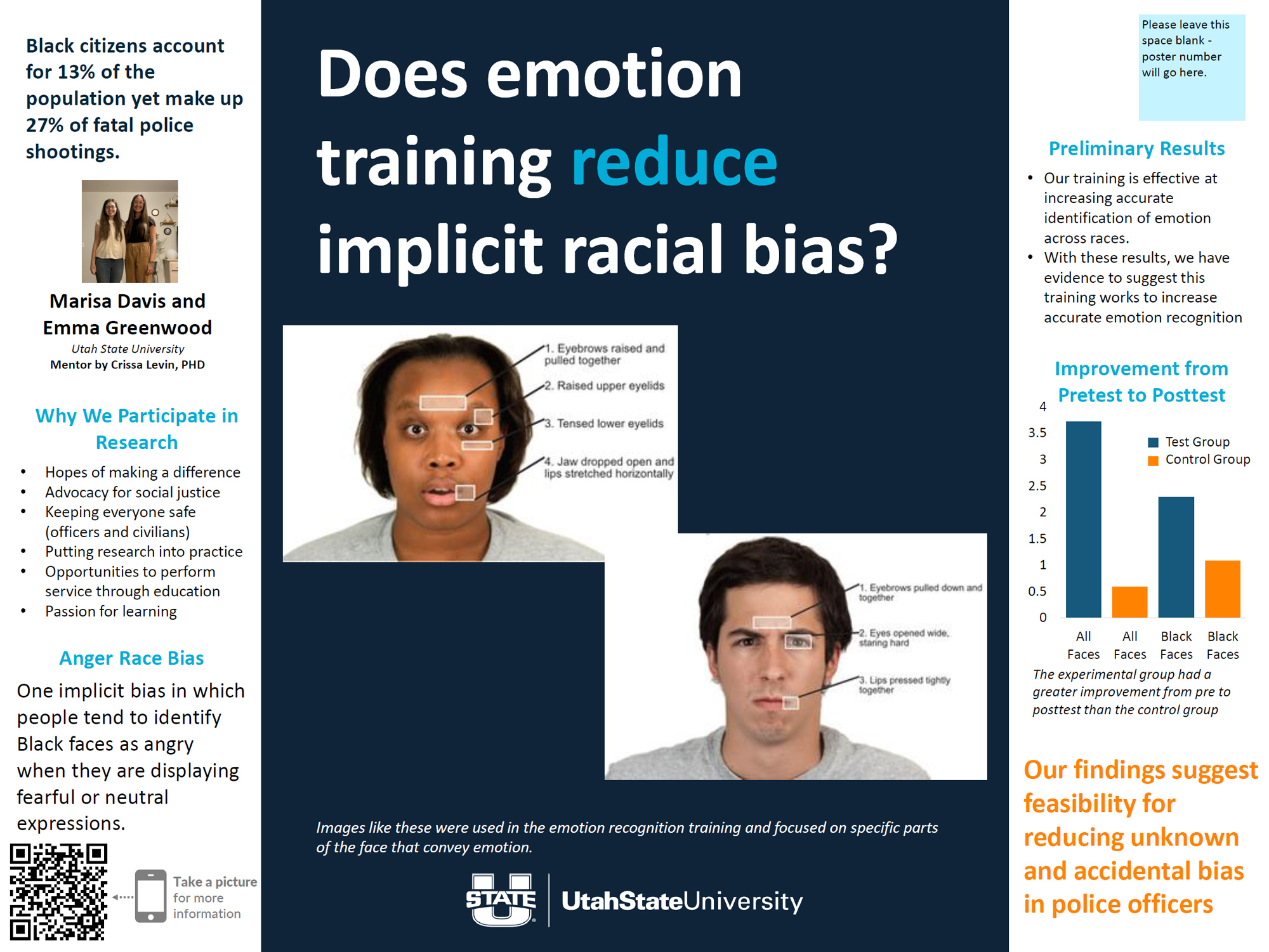Reducing Anger Race Bias Through Emotion Recognition Training

Introduction
Black Citizens account for 13% of the population, yet make up 27% of fatal policeshootings (Burghart, 2021). Anger race bias and misidentification of expressions of emotioncontributes to police perceiving Black suspects to be more hostile and dangerous than Whitesuspects (Nix et al., 2017). The purpose of this study is to investigate if anger race bias can bereduced through expression identification training.Expressions in minorities such as fear and surprise can be mistaken for aggression andanger (Hugenberg & Bodenhausen, 2003). Hugenberg and Bodenhausen (2003) found thatBlack faces are more likely to be seen as hostile more quickly and with more intensity thansimilar expressions on White faces. Results of another study showed that ambiguous faces weremore likely to be categorized as Black, and Black faces angrier than White faces, by participantsthat measured higher in implicit bias (Hutchings & Haddock, 2008).A study by Elfenbein (2006) aimed to see if training with outcome feedback couldincrease participant’s accurate identification of cross-cultural emotions. The researcherscompiled two similar sets of American and Chinese photographs displaying fear, anger, sadness,surprise, and happiness. Participants were randomized into two groups for a training sessionwhere they were shown a photo, asked to identify the emotion shown, and then given instantoutcome feedback. After the training session, participants were tested using the set of photosthey had not seen during training. Accuracy in identifying emotions was higher on the posttestmeasure than the training sessions, indicating that training can improve cross-cultural emotionrecognition.Previous research has not tested ways in which bias towards Black faces expressing fearcan be reduced through emotion recognition training. The present study builds on the findings inprevious studies that implicit race bias can be reduced through training and intervention. Thehypothesis is that by training participants to recognize emotions, anger race bias will be reduced.ParticipantsParticipants will be 18+ years old undergraduates at USU. This study plans to recruit 352participants. Participants will be split into two groups: those who receive the training and thosewho do not.
Methods
For the pretest, participants are tested on emotional identification in Black and Whitefaces displaying emotions of neutrality, fear, and anger. They will also be tested on Asian andLatinX faces displaying neutrality. Following the pretest, participants in the experimental groupwill view a training that instructs them on how to identify the emotions of fear, anger, andneutrality based on three sections of the face: the forehead, eyes, and mouth. Participants in thecontrol group will view a training that informs participants on various elements of emotionalintelligence, such as mimicry. Then, participants will take the post-test, which will have the sameset-up as the pre-test but with new faces. Two weeks later, the participants will be invited to takea follow-up test which will have the same structure as the previous surveys and include facesfrom each of them. (If participants complete the follow-up, they have a one in nine chance to win$40.) A month after completion of the study, follow-up completed or not, participants will bedebriefed and the true purpose of the study (studying race) will be explained.
Preliminary Results
We are still in the process of collecting data, therefore these results are not complete and will be updated when we have a greater effect size. Currently, our results demonstrate that our emotion identification training can feasibly improve participants’ ability to recognize emotions in races overall, 95% CI [0.050, 6.213], t(20.16)=2.118, p<.05. Participants in the experimental group had a mean improvement of 3.714 (SD = 3.138) from baseline to post test, and participants in the control group had a mean improvement of 0.583 (SD = 4.21).While analyzing for improvement specifically in Black faces from pre to post test, there is no statistical significance. However, there was a mean difference of 1.202 between the test and control group, with the control group improving 2.286 points (SD = 2.128) from baseline to post test and the control group improving 1.083 points (SD = 2.392) from baseline to post test, 95% CI [-0.627, 3.031], t(24)=1.357, p=.187.
References
Burghart, Brian.Our visualizations – Fatal Encounters. (2021).Elfenbein, H. A. (2006). Learning in emotion judgments: Training and the cross-cultural understanding of facial expressions. Journal of Nonverbal Behavior, 30(1), 21-36.
Hugenberg, K., & Bodenhausen, G. V. (2003). Facing prejudice: Implicit prejudice and the perception of facial threat. Psychological Science, 14(6), 640-643.
Hutchings, P. B., & Haddock, G. (2008). Look Black in anger: The role of implicit prejudice in the categorization and perceived emotional intensity of racially ambiguous faces. Journal of Experimental Social Psychology, 44(5), 1418-1420.
Nix, J., Campbell, B. A., Byers, E. H., & Alpert, G. P. (2017). A bird's eye view of civilians killed by police in 2015: Further evidence of implicit bias. Criminology & Public Policy, 16(1), 309-340

